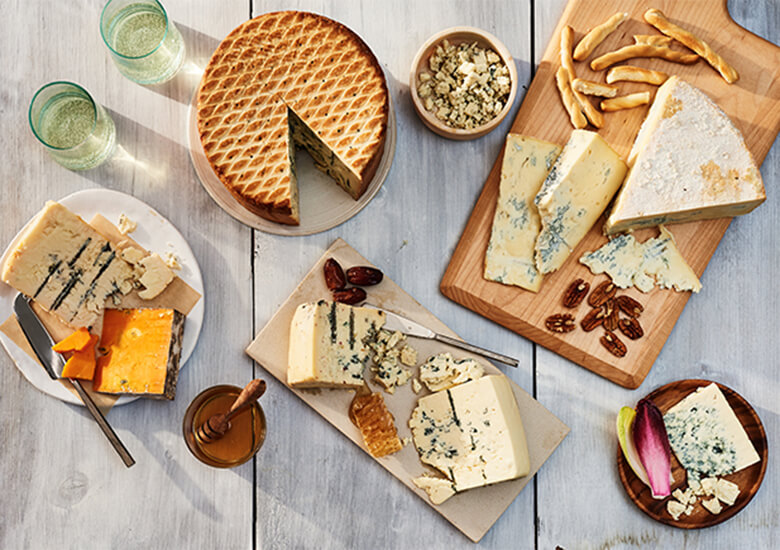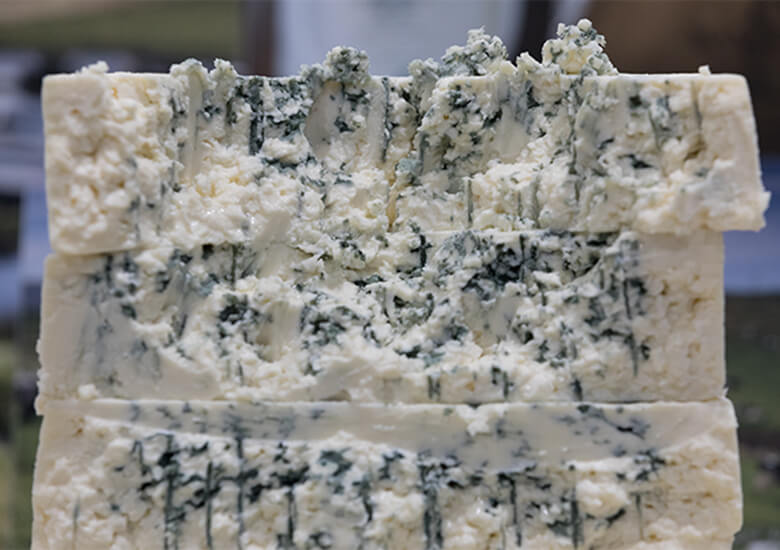You probably grew up being told to not eat moldy things in the fridge. And while we’re not doctors, if you spot a green and hairy growth on your yogurt, you probably shouldn’t eat it. But mold can be a beautiful thing when carefully—even lovingly—cultivated in safe conditions.
The Relationship Between Mold and Cheese

One of the most fascinating aspects of cheesemaking is the transformation from the humble curd to a gorgeous blue-veined cheese like gorgonzola or a brilliant camembert. What starts as a nearly blank slate becomes a complex and unique creation over the course of a few short months.
Cheesemakers couldn’t make this transformation happen without the help of some friendly, intentionally placed microorganisms like mold. In fact, many of our favorite cheeses owe their incredible flavors to the magic of mold.
So, if mold is such an essential part of the cheesemaking process, why do we avoid eating some forms of mold? It all comes down to the intention. Part of a cheesemaker’s job is to carefully manage the species of mold that are added to their cheese.
Mold needs to grow in the right place and at the right time in order to create the flavors and textures we love and can safely digest. Although many of us get squeamish around the topic of mold, we can promise you that the ones used to make cheese are 100% safe to eat.
The mold that happens when you accidently abandon a half-eaten block of cheddar in the back of your fridge for seven weeks? That’s a different story.
All About Moldy Cheese

Which kinds of cheese are made with mold?
There are countless varieties of cheese that use mold at different stages of the cheesemaking process. Some cheeses have mold introduced to help create a protective rind, and others like blue are spiked with stainless steel rods to help infuse the mold deep into the cheese. Below are some of our favorites.
Blue Cheese: Some say that blue cheese is an acquired taste. As far as we’re concerned, the taste is acquired in no time at all once you give this blue-veined beauty a chance! Blue cheese runs the gamut from relatively mild and creamy to pungent and crumbly. For those new to blue cheese, we recommend starting with something on the creamy and mild end of the spectrum. Roth’s Buttermilk Blue® is a sure-fire way to fall in love with blue cheese and turn skeptics into blue-ievers.
Blue Cheddar: This Wisconsin original is a great way to expand the boundaries of your cheese tasting while keeping things familiar. Blue cheddar is aged cheddar infused with Penicillium roqueforti, the fungus responsible for developing blue cheese’s iconic veins and flavor. Basically, it’s the best of both worlds.
Gorgonzola: Gorgonzola is kind of like blue cheese’s older, more conservative Italian-style relative. Gorgonzola was brought to Wisconsin by Italian immigrants and soon local cheesemakers quickly put their own spin on this timeless classic. Compared to blue, gorgonzola tends to be a bit milder and traditionally uses a different species of mold—Penicillium glaucum—to create its similar blue veins. Where blue cheese pushes the limit, gorgonzola stays in its very delicious lane.
Other types of moldy cheese
Washed-rind (or smear-ripened) cheeses: They say it takes a village to raise a child; we say it takes an old cheese to raise a young cheese. Or at least that’s the case for some washed-rind or smear-ripened cheeses, which use the bacteria on a mature cheese to cultivate a new colony on a younger cheese.
But it’s not quite as simple as smearing an older cheese on a younger cheese. Cheesemakers are careful to wash these cheeses regularly to ensure that the intended bacteria develop evenly and that other unwanted molds don’t grow. More commonly, cheesemakers simply rub a solution of carefully selected bacteria onto the young cheese during the aging process.
Some cheeses are also cured in a briny solution while they age, which is pretty much an open invitation for a group of bacteria known as Brevibacterium linens to make that cheese their new home. As the bacteria settles in, it produces piquant odors and distinctive flavors. Some washed-rind cheeses are soft, like limburger; others are semi-hard or hard like montague.
Bloomy-rind cheeses: Commonly found on soft, rich cheeses like Hoard’s St. Saviour or Schroeder Käse Camembert, bloomy rinds are surfaced-ripened cheeses known for their white rinds. These cheeses are coated with with Penicillium candidum during the aging process. This famous mold culture is responsible for the edible, white rind and contributes to the creamy interior texture of bloomy rind cheeses.
Is cheese made from mold?

Cheese is not mold nor is it the by-product of mold. Some cheese varieties like blue cheese have specific species of mold that are intentionally added during the cheesemaking process to enhance the flavor or texture. The mold added to these cheeses can be thought of as a special ingredient.
Can you eat cheese with mold on it?

It depends on the cheese. For fresh cheeses like mozzarella or ricotta, mold is an unfortunate sign that it’s time to part ways and discard your cheese. Because fresh cheeses are high in moisture, mold can spread quickly and make the cheese unsafe to eat.
For aged or hard cheeses like parmesan, or cheddar, light surface mold can be dealt with by cutting around the moldy bit and removing it. Roughly an inch around and an inch deep is a good rule of thumb for how much to cut away. Because hard cheeses are so dense and have less moisture, mold can’t penetrate as deeply into the cheese.
How can you prevent mold from growing on cheese?
Proper storage is your number one strategy to preventing unwanted mold growth on cheese. In fact, we have a whole guide dedicated to safe cheese storage.
In short, we recommend carefully wrapping your cheese in parchment paper and storing it in one of your humidity controllable drawers, such as a vegetable crisper. Parchment paper helps your cheese breathe while still providing a protective barrier against unwanted germs.
Befriend the mold!
If all this talk of cheese has gotten you hungry for a cheese tasting, you can get Wisconsin’s finest moldy cheeses delivered right to your door with our continuously updated list of cheesemakers and retailers that allow you to order cheese online. Award-winning Wisconsin cheese is just a click away!
Craving something else? Choose from our selection of over 300 recipes featuring Wisconsin cheese. Don’t forget to share your creative cheesy creations with us on Facebook and Instagram.
